SUMMARY OF FINDINGS
INTRODUCTION
This publication presents information from the National Prisoner Census about persons held in Australian prisons on the night of 30 June 2007. The National Prisoner Census covers all prisoners in the legal custody of adult corrective services in adult prisons, including periodic detainees in New South Wales and the Australian Capital Territory, but excluding persons held in juvenile institutions, psychiatric custody and police custody. It is based on data extracted from administrative records held by the corrective services agencies in each Australian state and territory. These statistics provide a profile of the legal status and sentence details as well as demographic characteristics of Australian adult prisoners.
Users of this publication should note that it provides a picture of the persons in prison at a point in time (30 June 2007), and does not represent the flow of prisoners during the year. The majority of prisoners in the annual Prisoner Census were serving long-term sentences for serious offences, whereas the flow of offenders in and out of prisons consists primarily of persons serving short sentences for lesser offences. Complementary information to this publication about Australian prisoners is available in the Australian Bureau of Statistics (ABS) quarterly publication, Corrective Services, Australia (cat.no. 4512.0).
The Explanatory Notes provide detailed information on the data sources, definitions, counting rules and other technical matters associated with this publication.
For ease of reading, 'most serious offence/charge' may be referred to as 'offence/charge' throughout this publication. The term 'related offences' has also been omitted for ease of reading for the following offences/charges: homicide and related offences; sexual assault and related offences; robbery, extortion and related offences; theft and related offences; and deception and related offences.
PRISONER SNAPSHOT
At 30 June 2007 there were 27,224 prisoners (sentenced and unsentenced) in Australian prisons, an increase of 6% (1,434 prisoners) since 30 June 2006. This represented an imprisonment rate of 169 prisoners per 100,000 adult population. The median aggregate sentence length for all prisoners was three years.
Unsentenced prisoners comprised 22% (6,096) of the total prisoner population, an increase of 9% (515 prisoners) from 30 June 2006. Over half (57%) of all prisoners had recorded that they served a sentence in an adult prison prior to the current episode. The most serious offence/charge of acts intended to cause injury accounted for the highest proportion (19% or 5,038) of all prisoners.
Of the total prisoner population, 7% (1,984) were female and 24% (6,630) were Indigenous. Over 79% (21,540) of all prisoners were born in Australia. The median age of all prisoners was 33 years, unchanged from 2006. Over 70% (20,035) of the total prisoner population was located in New South Wales (10,285), Queensland (5,567) and Victoria (4,183).
CHANGES IN THE PRISONER POPULATION
The total prisoner population increased by 6%, from 25,790 on 30 June 2006 to 27,224 on 30 June 2007. Between these two Prisoner Census dates:
- the number of male prisoners increased by 5% (1,277) and the number of female prisoners increased by 9% (157);
- the number of Indigenous prisoners increased by 9% (539);
- sentenced prisoners increased by 5% (919) and the number of unsentenced prisoners increased by 9% (515);
- there was an increase of 3% (439) of prisoners recording prior adult imprisonment.
CHANGE IN PRISONER NUMBERS, between 30 June 2006 and 30 June 2007
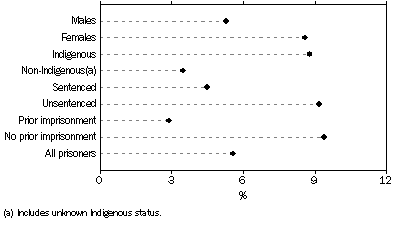
Between 2006 and 2007, the prisoner population increased in all states and territories. The highest proportional increases in prisoner numbers were for the Northern Territory (14%) and South Australia (13%), followed by Western Australia and the Australian Capital Territory (both 9%).
CHANGE IN PRISONER NUMBERS, between 30 June 2006 and 30 June 2007, states and territories
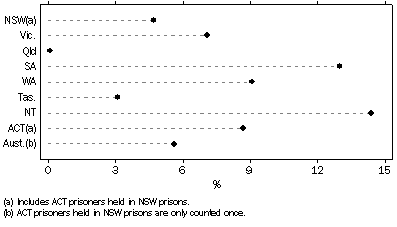
IMPRISONMENT RATES
At 30 June 2007, the Australian imprisonment rate was 169 prisoners per 100,000 adult population, a rise of 4% (or 163 prisoners) from 30 June 2006 and an increase of 23% from 30 June 1997 (137 prisoners).
IMPRISONMENT RATES(a)
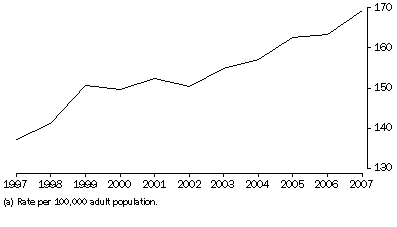
Imprisonment rates increased in all states and territories, except Queensland, between 30 June 2006 and 30 June 2007. South Australia (11%) and the Northern Territory (10%) recorded the largest imprisonment rate increases, while Queensland recorded a 3% decrease. At 30 June 2007, Northern Territory had the highest imprisonment rate at 595 prisoners per 100,000 adult population.
Since 1997, all states and territories had recorded increased imprisonment rates. Tasmania recorded the largest percentage change in the imprisonment rate, rising 86% (from 76 prisoners per 100,000 adult population in 1997 to 141 prisoners per 100,000 adult population in 2007). This was followed by Western Australia increasing by 42% (from 170 to 242 prisoners per 100,000 adult population) and Victoria increasing by 39% (from 75 to 105 prisoners per 100,000 adult population).
CHANGE IN IMPRISONMENT RATES(a), between 30 June 1997 and 30 June 2007, states and territories
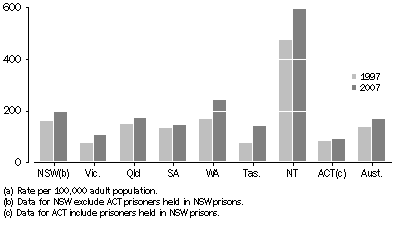
INDIGENOUS PRISONERS
Caution should be exercised when interpreting movements in Indigenous prisoner numbers as increases may have been impacted by changes to the collection and recording of Indigenous information, or the willingness of Indigenous persons to self identify.
Indigenous prisoners represented 24% of the total prisoner population at 30 June 2007, no change from 30 June 2006.
The proportion of prisoners that were Indigenous was variable across states and territories. The Indigenous prisoner population in the Northern Territory comprised 84% of the total prisoner population for that territory, while Victoria had the lowest proportion of Indigenous prisoners (6%).
When comparing rates of imprisonment for Indigenous and non-Indigenous prisoners, it is preferable to use age standardised rates. (For further information see Explanatory Notes, paragraphs 28-33). The age standardised imprisonment rate for Indigenous prisoners was 1,787 per 100,000 adult Indigenous population, indicating that Indigenous persons were 13 times more likely than non-Indigenous persons to be in prison at 30 June 2007, unchanged from 2006.
Indigenous persons were 21 times more likely to be in prison than non-Indigenous persons in Western Australia; the highest age standardised ratio of Indigenous to non-Indigenous rates of imprisonment in Australia.
RATIO OF INDIGENOUS TO NON-INDIGENOUS AGE STANDARDISED RATES OF IMPRISONMENT(a)
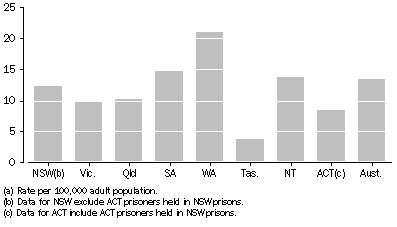
COUNTRY OF BIRTH
At 30 June 2007, Australia was the country of birth recorded by 79% (21,500) of all prisoners (sentenced and unsentenced). This was followed by New Zealand (3% or 710 prisoners), the United Kingdom and Ireland (2% or 662), Vietnam and Lebanon (2% or 610).
MOST SERIOUS OFFENCE/CHARGE
An offence/charge is determined for each prisoner (see Explanatory Notes, paragraphs 70-73). At 30 June 2007, the most prevalent offences/charges for prisoners (either sentenced or unsentenced) were: acts intended to cause injury (19%); unlawful entry with intent (12%); sexual assault (11%); homicide and illicit drug offences (both 10%); and robbery and extortion (9%).
SEX
Males comprised 93% (25,240) of the total prisoner population at 30 June 2007, whilst females comprised 7% (1,984). The number of male prisoners increased by 5% (1,277) and female prisoners increased by 9% (157) from 30 June 2006.
Over the 10 years to June 2007, the number of prisoners increased by 42%, from 19,128 at 30 June 1997 to 27,224 at 30 June 2007. For the same period, the number of male prisoners increased by 40% (from 18,038 to 25,240) and the number of female prisoners increased by 82% (from 1,090 to 1,984).
CHANGE IN PRISONER NUMBERS, between 30 June 1997 and 30 June 2007, by sex
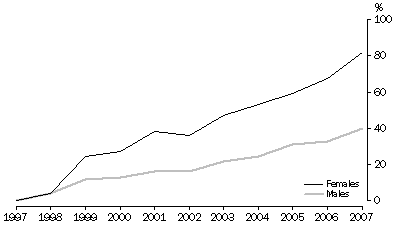
At 30 June 2007, the Australian imprisonment rate for females was 24 prisoners per 100,000 adult female population, an increase from 15 prisoners per 100,000 adult female population in 1997. Between 1997 and 2007 the female imprisonment rate increased in all states and territories. In the Northern Territory, the female imprisonment rate increased from 34 to 56 prisoners per 100,000 adult female population while in Western Australia, the female imprisonment rate increased from 22 to 41 prisoners per 100,000 adult female population. From a low base in 1997, Tasmania recorded the highest proportional increase in the female imprisonment rate, an increase of 493%. The imprisonment rate increased from 3 to 17 per 100,000 Tasmanian adult female population.
FEMALE IMPRISONMENT RATES, between 30 June 1997 and 30 June 2007, states and territories
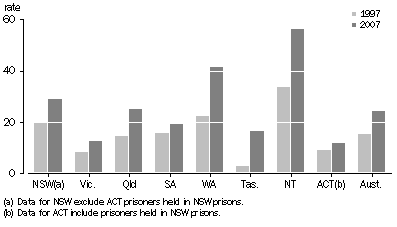
The imprisonment rate for males increased by 24% from 1997, representing a rate of 320 males per 100,000 adult male population. This compared to 258 prisoners per 100,000 adult male population in 1997. Over the 10 years from June 1997, Tasmania recorded the highest proportional change in male imprisonment rates, an increase of 82% (from 149 to 272 male prisoners per 100,000 adult male population). Male imprisonment rates increased by 43% in Western Australia (from 309 to 441 per 100,000 adult male population) and 40% in Victoria (from 144 to 201 per 100,000 adult male population).
MALE IMPRISONMENT RATES, between 30 June 1997 and 30 June 2007, states and territories
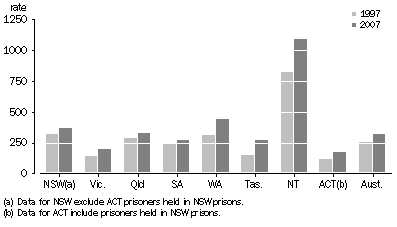
AGE
The median age of all prisoners in Australian prisons at 30 June 2007 was 33 years, the same median age for both males and females. In contrast, the median age of male Indigenous prisoners was 31 years, while the median age for Indigenous female prisoners was 30 years.
Just under 70% of all prisoners were aged between 20 and 39 years. The highest proportion of non-Indigenous prisoners was in the 25-29 age group (19%), while for Indigenous prisoners the 20-24 age group was the highest (22%).
Other than for sexual assault, the majority of prisoners in all selected offence/charge categories were aged 25-34 years. For sexual assault, the highest proportion of prisoners were aged 35-44 years.
Prisoners with an offence/charge of sexual assault had the highest median age (42 years).
PROPORTION OF PRISONERS, selected offence/charge, by age group
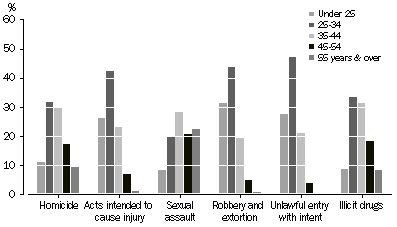
Comparing different age groups:
- prisoners 55 and over were more likely to be imprisoned for sexual assault than for other offence/charge types and were least likely to be imprisoned for robbery and extortion;
- the highest proportion of prisoners aged 45-54 were in prison for the offence/charge of sexual assault;
- for each of the remaining age groups, the highest proportion of prisoners within that age group were in prison for acts intended to cause injury.
PROPORTION OF PRISONERS, age groups by selected offence/charge
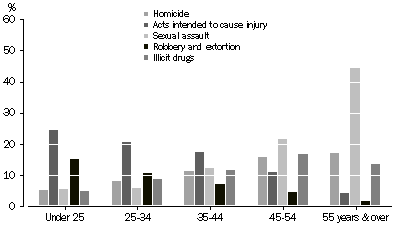
PRIOR IMPRISONMENT
The majority (57%) of prisoners in custody at 30 June 2007 had served a sentence in an adult prison prior to the current episode.
PRIOR IMPRISONMENT(a), selected most serious offence/charge
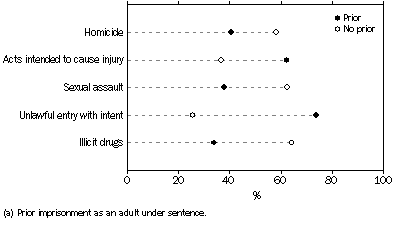
Almost 74% of prisoners with the offence/charge of unlawful entry with intent and 62% of prisoners with the offence/charge of acts intended to cause injury had a prior imprisonment recorded. Conversely, 64% of prisoners with an illicit drug offence/charge recorded no prior imprisonment.
SENTENCED PRISONERS
There were 21,128 sentenced prisoners in Australian prisons at 30 June 2007, an increase of 5% (918 sentenced prisoners) from 30 June 2006 (20,210).
Most serious offence
Six offences accounted for 70% of all sentenced prisoners: acts intended to cause injury (16%); sexual assault (13%); unlawful entry with intent (12%); and homicide, offences against justice and illicit drugs (all 10%).
Over the 10 years from June 1997, the proportion of sentenced prisoners with an offence of acts intended to cause injury increased from 12% to 16% in 2007. The proportion of prisoners with an offence of robbery and extortion decreased over the same period from 13% in 1997 to 9% in 2007.
Nationally, the most serious offence accounting for the largest proportion of sentenced prisoners was acts intended to cause injury (16%). The Northern Territory had the largest proportion of sentenced prisoners for this offence (38%), followed by New South Wales and Queensland (both 17%), and Western Australia and Tasmania (both 16%). For Victoria, 15% of sentenced prisoners had an offence of sexual assault, while homicide accounted for 13% of sentenced prisoners. Tasmania had the highest proportion of sentenced prisoners (19%) with an offence of sexual assault and New South Wales recorded the lowest proportion (8%). New South Wales had the highest proportion of sentenced prisoners with an offence of illicit drugs (13%).
PROPORTION OF SENTENCED PRISONERS, selected most serious offence, states and territories
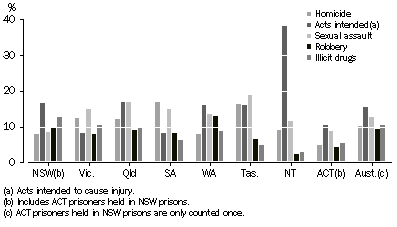
Prisoners sentenced in the last 12 months
Over half (54% or 11,450) of all sentenced prisoners were sentenced in the 12 months preceding 30 June 2007. The majority (62%) of these prisoners had served a sentence in an adult prison prior to the current episode being served.
Sex
The number of sentenced males in prison increased by 4,085 (26%) from 1997. The largest increase was in the number of sentenced prisoners with an offence of acts intended to cause injury, increasing by 1,022 (49%). This was followed by increases of male prisoners for the following offences: homicide (545 or 37%); illicit drugs (458 or 31%); and sexual assault (475 or 22%).
SENTENCED MALES IN PRISON, selected most serious offence
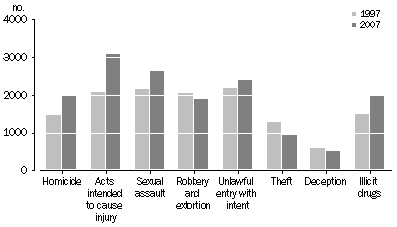
From 30 June 1997 to 30 June 2007 the number of sentenced females in prison had increased from 919 to 1,440 (57%). Increases in the number of sentenced females in prison were recorded for the following offences: acts intended to cause injury (97 or 104%); homicide (75 or 93%); and illicit drugs (86 or 68%).
SENTENCED FEMALES IN PRISON, selected most serious offence
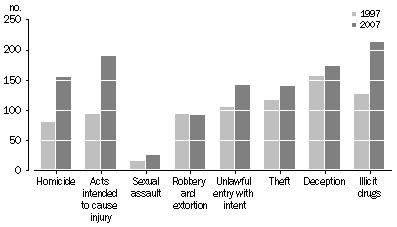
Indigenous prisoners
Over 43% (2,204) of all Indigenous prisoners were sentenced for acts intended to cause injury and unlawful entry with intent. In contrast, these same offences accounted for 23% of all non-Indigenous sentenced prisoners (both at 11% respectively). Sexual assault accounted for the highest proportion of non-Indigenous prisoners (13% or 2,134), followed by illicit drug offences (13% or 2,090).
Aggregate sentence length
Of all sentenced prisoners, 5% (1,045) were serving a life term or another indeterminate sentence. Of the remaining sentenced prisoners, 23% had an aggregate sentence length imposed in the range from 2 years to less than 5 years, while 21% had an aggregate sentence length of between 5 years and under 10 years. More than 34% (7,276) had an aggregate sentence length of less than 2 years. Periodic detention accounted for 4% of all sentenced prisoners.
Excluding prisoners with indeterminate, life term and periodic detention sentences, the median aggregate sentence length for sentenced prisoners was unchanged from 2006 at 3 years (36 months). For information about interpreting mean and median sentence lengths based on a census 'snapshot' see Explanatory Notes, paragraphs 67-69.
The longest median aggregate sentence lengths at 30 June 2007 were for homicide (15 years or 180 months), sexual assault (7 years or 84 months) and robbery and extortion (6 years or 72 months). The median aggregate sentence lengths for all three of these offences remained unchanged from 30 June 2006.
Between 30 June 2006 and 30 June 2007, the largest increase in median aggregate sentence lengths were for the most serious offence categories of abduction (an increase from 68 months to 78 months) and property damage and environmental pollution (an increase from 16 months to 24 months).
Excluding prisoners with indeterminate, life term and periodic detention sentences, the median aggregate sentence length for Indigenous prisoners was 2 years, while for non-Indigenous prisoners it was 3.5 years. This compares to 1.8 years and 3.7 years respectively at 30 June 2006.
Expected time to serve
Expected time to serve takes into account the earliest date of release for sentenced prisoners. The median expected time to serve for sentenced prisoners at 30 June 2007 was 1.8 years (21.6 months), a decrease from 1.9 years (22.4 months) in 2006. Excluding prisoners with indeterminate, life without a minimum, and periodic detention sentences, over 20% of prisoners (4,305) had an expected time to serve greater than 5 years, while 23% of prisoners had an expected time to serve between 2 and under 5 years.
The median expected time to serve was highest for the offence category of homicide (10.8 years or 129.8 months), followed by sexual assault (4.5 years or 54 months), abduction (4.3 years or 51 months) and robbery (3.7 years or 44 months).
SENTENCED PRISONERS, median sentence length and selected most serious offence(a)
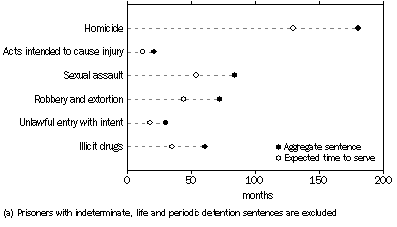
UNSENTENCED PRISONERS
Unsentenced (those on remand) prisoners include unconvicted prisoners awaiting a court hearing or trial, convicted prisoners awaiting sentencing and persons awaiting deportation where they are under the administration of Corrective Services Australia. The proportion of unsentenced prisoners to the total prisoner population in Australian prisons at 30 June 2007 was 22%, unchanged from 30 June 2006. There was a total of 6,096 unsentenced prisoners, an increase of 9% from 30 June 2006 (5,581).
All states and territories reported an increase in the proportion of remandees except for Tasmania (a decrease of 1%) and the Northern Territory (a decrease of 5%). Of all states and territories, South Australia had the highest proportion (35%) of unsentenced prisoners, while the Northern Territory had the lowest proportion of unsentenced prisoners (17%).
Most serious charge
Of all unsentenced prisoners, 29% had a most serious charge of acts intended to cause injury, followed by unlawful entry with intent (12%), robbery and extortion (10%) and illicit drug offences (9%).
Time on remand
Time on remand is influenced by a number of factors, particularly the time it takes for a case to come before a court. The median number of months spent on remand by unsentenced prisoners in custody at 30 June 2007 was 2.7 months while at 30 June 2006 it was 2.6 months. For information about interpreting median time on remand based on a census 'snapshot' see Explanatory Notes, paragraphs 67-69. The longest amount of time spent on remand was by prisoners charged with homicide (median of 9 months), followed by abduction (median of 4.7 months). This compares to a median of 8.8 months and 4 months for these same offence types at 30 June 2006.
PERIODIC DETAINEES
The sentencing option of periodic detention, where detainees are in custody for two consecutive days in a week and remain at liberty the rest of the week, is available only in New South Wales and the Australian Capital Territory. There were 830 periodic detainees at 30 June 2007, an increase of 7% from 30 June 2006 (53 periodic detainees). More than half (52% or 429) of periodic detainees were sentenced for road traffic and motor vehicle regulatory offences (243) and acts intended to cause injury (186).
 Print Page
Print Page
 Print All
Print All